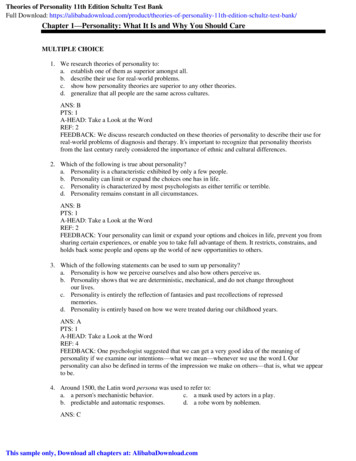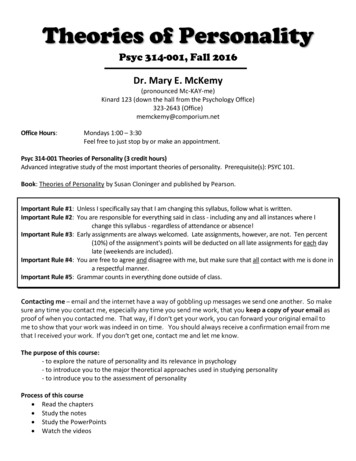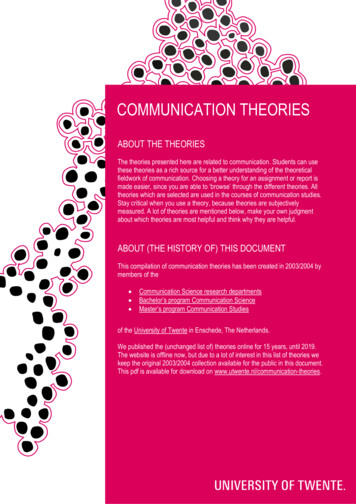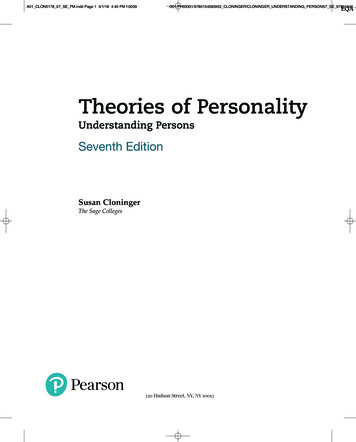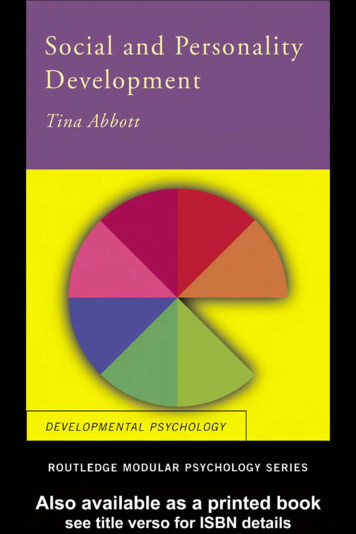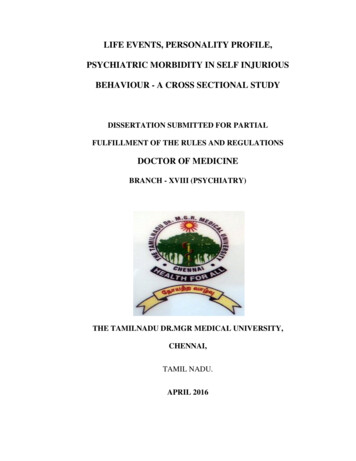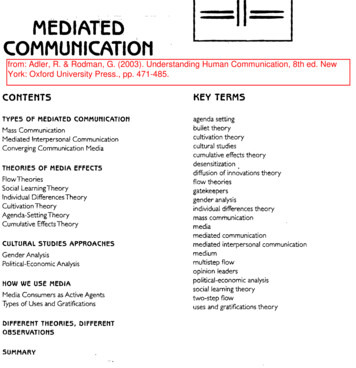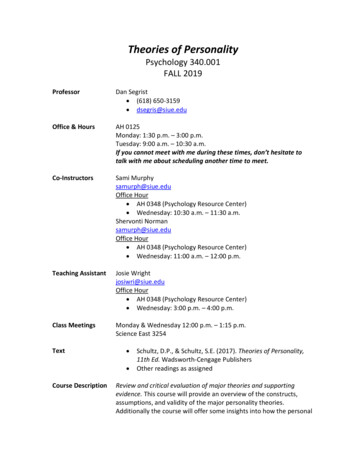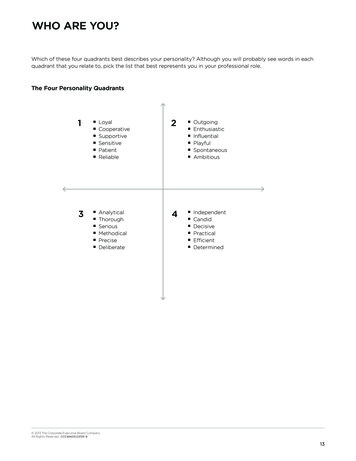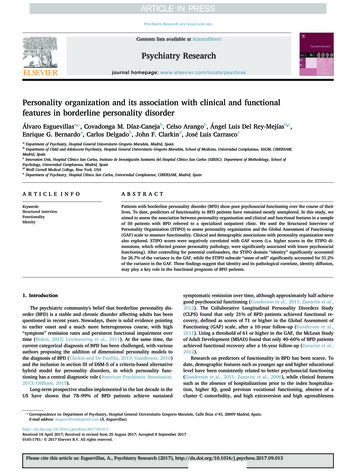
Transcription
N I N T HE D I T I O NTheoriesof PersonalityRichard M. RyckmanUniversity of MaineAustralia Brazil Canada Mexico Singapore Spain United Kingdom United States
Theories of Personality, Ninth EditionRichard M. RyckmanPublisher: Michele SordiAssistant Editor: Magnolia MolcanEditorial Assistant: Erin MiskellyAssociate Technology Project Manager: Lauren KeyesExecutive Marketing Manager: Kim RussellMarketing Assistant: Natasha CoatsSenior Marketing Communications Manager: Linda YipContent Project Manager: Karol JuradoCreative Director: Rob HugelSenior Art Director: Vernon BoesSenior Print Buyer: Judy InouyePermissions Editor: Sue HowardProduction Service: ICC Macmillan Inc.Photo Researcher: Sue HowardCopy Editor: David AbelIllustrator: ICC Macmillan Inc.Cover Designer: Cheryl CarringtonCover Art: 2006 Paul Heussenstamm,heartcenter@mandalas.comCover Printer: Thomson WestCompositor: ICC Macmillan Inc.Printer: Thomson West 2008, 2004 Thomson Wadsworth, a part of TheThomson Corporation. Thomson, the Star logo, andWadsworth are trademarks used herein under license.Thomson Higher Education10 Davis DriveBelmont, CA 94002-3098USAALL RIGHTS RESERVED. No part of this workcovered by the copyright hereon may be reproduced orused in any form or by any means—graphic, electronic,or mechanical, including photocopying, recording,taping, Web distribution, information storage and retrieval systems, or in any other manner—without thewritten permission of the publisher.Printed in the United States of America1 2 3 4 5 6 7 11 10 09 08 07ExamView and ExamView Pro are registeredtrademarks of FSCreations, Inc. Windows is a registered trademark of the Microsoft Corporation usedherein under license. Macintosh and Power Macintoshare registered trademarks of Apple Computer, Inc.Used herein under license.Library of Congress Control Number: 2006937651ISBN-13: 978-0-495-09908-6ISBN-10: 0-495-09908-2For more information about our products, contact us at:Thomson Learning Academic Resource Center1-800-423-0563For permission to use material from this text orproduct, submit a request online athttp://www.thomsonrights.com.Any additional questions about permissionscan be submitted by e-mail tothomsonrights@thomson.com.
Darling Leona:May we dance in lovely harmony among the stars.
ContentsPrefacexvPART ONEAn Introduction to the DisciplineCHAPTER 1PERSONALITY AND THE SCIENTIFIC OUTLOOKWhy Study Personality? 2Defining Personality 4The Scientific Study of PersonalityBuilding Scientific Theories 615Inductive versus Deductive ApproachesThe Establishment of Laws 86Testing the Theories: Research Methods8Experimental Method 9Correlational Method 11Case-Study Method 15Criteria for Evaluating Scientific TheoriesCritical Thinking Questions 20Glossary 21Suggested Readings 25iv172
ContentsPART TWOPsychoanalytic and Neoanalytic PerspectivesCHAPTER 2FREUD’S PSYCHOANALYTIC THEORY32Biographical Sketch 32Concepts and Principles 36The Role of Conscious, Preconscious, and UnconsciousForces in Personality 36Instincts: The Driving Forces in Personality 37Structural Theory of Personality and Its Dynamics 39Defense Mechanisms 41Personality Development45The Theory of Psychosexual Development 45Character Types 49Research Evidence for the Theory of PsychosexualDevelopment 51Assessment Techniques57Free Association 57Dream Analysis 60Transference 61Theory’s Implications for TherapyEvaluative Comments 63Critical Thinking Questions 68Glossary 68Suggested Readings 73CHAPTER 363JUNG’S ANALYTICAL PSYCHOLOGYBiographical Sketch 74Concepts and Principles 78The Psyche 78Archetypes 82The Theory of Psychological TypesPersonality Development96Self-Realization 96Neurosis and PsychosisAssessment Techniques9798Dream Analysis 99Method of Amplification 100Word Association Test 101Painting Therapy 1018874v27
viContentsTheory’s Implications for TherapyEvaluative Comments 104Critical Thinking Questions 107Glossary 107Suggested Readings 110CHAPTER 4102ADLER’S INDIVIDUAL PSYCHOLOGY112Biographical Sketch 112Concepts and Principles 114The Struggle for Perfection 115Creative Evolution and Social Interest 116Feelings of Inferiority and the Striving for SuperiorityStyle of Life and the Creative Self 119Personality Development120Three Basic Developmental Problems of Life 120Parental Influence in Early Childhood 121Birth Order 122Birth Order Research Evidence 124Development of a Destructive Lifestyle 129Development of a Constructive Lifestyle 130Adler’s Four Major Lifestyle Types 130Assessment Techniques132Early Recollections 132Dream Analysis 133Birth-Order Analysis 134Theory’s Implications for TherapyEvaluative Comments 135Critical Thinking Questions 137Glossary 138Suggested Readings 139CHAPTER 5134HORNEY’S SOCIAL AND CULTURALPSYCHOANALYSIS 140Biographical Sketch 140Concepts and Principles 143Hypercompetitiveness: The Unfailing Centerof Neurosis 143Personal Development Competitiveness: Competingin a Psychologically Healthy Way 146The Etiology of Neuroses in the Family 146The Use of Neurotic Strategies to Cope with Feelingsof Basic Anxiety 147118
ContentsviiThe Three Basic Neurotic Trends 151The Basic Conflict in Neurosis 152Personality Development155Horney’s Critique of Freud 155Horney’s Humanistic View of DevelopmentEmpirical Evidence: Irrational Beliefsand Psychopathology 164Assessment Techniques 165Theory’s Implications for TherapyEvaluative Comments 167Critical Thinking Questions 169Glossary 170Suggested Readings 171CHAPTER 6160166ERIKSON’S PSYCHOANALYTICEGO PSYCHOLOGY 172Biographical Sketch 172Concepts and Principles 177Ego Psychology: Liberalizing the PsychoanalyticPosition 177The Epigenetic Principle 178Personality Development179The Stages of Ego Development 179Research Support for the Theory of Ego DevelopmentAssessment Techniques 202Theory’s Implications for TherapyEvaluative Comments 206Critical Thinking Questions 209Glossary 209Suggested Readings 213CHAPTER 7KOHUT’S SELF PSYCHOLOGY189204214Biographical Sketch 214Concepts and Principles 216Self Psychology: The Newest Development in ClassicalPsychoanalysis 216Self Psychology as Object-Relations Theory 217Personality Development218Pre-Oedipal Development of the Nuclear Self 218Pre-Oedipal Development: The Oral and Anal StagesOedipal Development: The Phallic Stage 224223
viiiContentsPost-Oedipal Development: The Latencyand Genital Stages 225Disturbances to the Self 228Typology for Narcissistic Personality and BehaviorDisorders 229The Role of Narcissism in the Development of the Self 233Research Support for the Theory of Self Development 236Assessment Techniques240Empathy as the Primary Data Collection ToolFree Association 241Dream Analysis 242Transference 243Theory’s Implications for TherapyEvaluative Comments 247Critical Thinking Questions 251Glossary 252Suggested Readings 256PART THREETrait PerspectivesCHAPTER 8ALLPORT’S TRAIT THEORY240245257264Biographical Sketch 264Concepts and Principles 266A Humanistic View of PersonalityThe Theory of Traits 268What Is a Trait? 269Personality Development266271The Proprium, or Self 271Development of the Mature Personality 275Functional Autonomy 276Characteristics of Maturity 277The Role of Religion as a Unifying Philosophy of LifeStudy of Values 282Assessment Techniques283Idiographic versus Nomothetic ApproachAn Idiographic Analysis 284Theory’s Implications for TherapyEvaluative Comments 289Critical Thinking Questions 290Glossary 291Suggested Readings 292287283279
ContentsCHAPTER 9CATTELL’S STRUCTURE-BASEDSYSTEMS THEORY 293Biographical Sketch 293Concepts and Principles 296Approach to Theory Building 296Methodology: Factor Analysis 298Defining Personality 301Classifying Traits 302Major Source Traits or Primary Factors 305Research with the 16 PF 311Major Global or Second-Order Factors 313The Major Abnormal Traits 314Dynamic Traits and the Dynamic Lattice 314The Econetic Model 318Dynamic Calculus 319Personality Development321The Role of Heredity and Environment 321The Role of Learning 321Theory of Abnormal Development 324Assessment Techniques 326Theory’s Implications for Therapy 327Beyondism: A New Morality Based on ScienceEvaluative Comments 333Critical Thinking Questions 335Glossary 336Suggested Readings 338CHAPTER 10 EYSENCK’S BIOLOGICAL TYPOLOGY328340Biographical Sketch 340Concepts and Principles 343Identifying and Measuring the Main Dimensionsof Personality 344Inhibition Theory 351Arousal Theory 353Personality Development360The Role of Heredity 360The Role of Socialization 362Intelligence, Heredity, and Social PolicyAssessment Techniques 367Theory’s Implications for Therapy364369Acquisition of Neurotic Behavior through ClassicalConditioning 369ix
xContentsElimination of Neurotic Behavior throughCounterconditioning 370Use of Behavior Therapy to Eliminate DisordersEvaluative Comments 374Critical Thinking QuestionsGlossary 377Suggested Readings 379372377PART FOURCognitive Perspectives381CHAPTER 11KELLY’S THEORY OF PERSONAL CONSTRUCTS384Biographical Sketch 384Concepts and Principles 386Constructive Alternativism 386Every Person as Scientist 387The Nature of Constructs and Construing 388Additional Characteristics of Constructs 389The Fundamental Postulate and Its Corollaries 391Personality Development 394Assessment Techniques 395The Role Construct Repertory Test 396Research Applications of the RCRT 399Theory’s Implications for Therapy403The Role of the Therapist 403The Therapeutic Conference and Role Playing 405Self-Characterization Sketches andFixed-Role Therapy 406Assessment and Treatment of Schizophrenics 408Evaluative Comments 411Critical Thinking QuestionsGlossary 413Suggested Readings 415PART FIVE413Humanistic/Existential Perspectives417CHAPTER 12 MASLOW’S SELF-ACTUALIZATION POSITIONBiographical Sketch 422Concepts and Principles 425Humanistic Biology and Self-ActualizationThe Hierarchy of Human Needs 425425422
ContentsB-Cognition and Actualization 432Characteristics of Self-Actualizing People433Personality Development 435Assessment Techniques 436Identifying Self-Actualizers 436The Personal Orientation Inventory 437Research Applications of the POI 440Theory’s Implications for TherapyEvaluative Comments 442Critical Thinking Questions 444Glossary 444Suggested Readings 446441CHAPTER 13 ROGERS’S PERSON-CENTERED THEORY447Biographical Sketch 447Concepts and Principles 450The Fundamental Perspective: The Person’s Experiencesas the Ultimate Authority 450The Master Motive: Self-Actualizing Tendency 450Personality Development451The Valuing Process in Infants 451The Valuing Process in Adults 453The Fully Functioning Person 454The Social Self and the True Self 456Empirical Support for the Self Theory 458Assessment Techniques 459Theory’s Implications for Therapy460Therapeutic Conditions That Facilitate Growth 461Empirical Support for the Theory of Therapy 463Theory’s Implications for Education 466Theory’s Implications for Marriage 468Evaluative Comments 471Critical Thinking Questions 472Glossary 473Suggested Readings 474CHAPTER 14 MAY’S EXISTENTIAL-ANALYTIC POSITIONBiographical Sketch 475Concepts and Principles 477What Is Existentialism? 477Existentialism and Psychoanalysis481475xi
xiiContentsThree Modes of Being-in-the-World 483Values Disintegration in Modern Society and the Lossof Our Moral Compass 484Emptiness and Loneliness 486The Emergence of Anxiety 488The Expansion of Consciousness 489Personality Development 490Assessment Techniques 492Theory’s Implications for TherapyThe Goal of Therapy 493The Case of Mrs. HutchensEvaluative Comments 494Critical Thinking QuestionsGlossary 496Suggested Readings 497PART SIX493493496Social-Behavioristic PerspectivesCHAPTER 15 SKINNER’S OPERANT ANALYSIS499505Biographical Sketch 505Concepts and Principles 508Scientific Behaviorism 508Free Will versus Determinism 511Personality from the Perspective of a RadicalBehaviorist 513Operant Conditioning 513Personality Development524A Schedule-of-Reinforcement Approach 524The Development of Normal and AbnormalPersonalities 526Assessment Techniques 527Theory’s Implications for Therapy527Psychopathology and Behavior ModificationTheory’s Implications for Education 540Theory’s Implications for Society 543Evaluative Comments 547Critical Thinking Questions 549Glossary 549Suggested Readings 552527
ContentsCHAPTER 16 ROTTER’S EXPECTANCY-REINFORCEMENTVALUE MODEL553Biographical Sketch 553Concepts and Principles 554Motivation 555Social-Learning Concepts557Personality Development 560Assessment Techniques 562Internal/External Control and the I-E ScaleResearch on I-E 565Theory’s Implications for TherapyEvaluative Comments 578Critical Thinking Questions 579Glossary 580Suggested Readings 580564575CHAPTER 17 BANDURA’S SOCIAL-COGNITIVE THEORY581Biographical Sketch 581Concepts and Principles 582Assumptions of the Social-Cognitive Approach 582Modeling Theory 585Aggression and Violence in Films, Television,and Video Games 587Research Evidence for Aggression and Violencein Our Society 588Efficacy Expectations 592Research on Self-Efficacy 595Personality Development 598Assessment Techniques 602Theory’s Implications for Therapy602Modeling of Others as a Therapeutic Technique 602Self-modeling as a Therapeutic Technique 606Efficacy Expectations and Fear Reduction 607Evaluative Comments 610Critical Thinking QuestionsGlossary 612Suggested Readings 613612xiii
xivContentsPART SEVENThe Role of the Grand Theories in ContemporaryPersonality Psychology615CHAPTER 18 THEORY AND RESEARCH IN CONTEMPORARYPERSONALITY PSYCHOLOGY616Heuristic Value of the Grand Theories in Five ImportantAreas 616Area 1: A Focus on Biological Contributionsto Personality 617Area 2: The Need for a Multicultural Perspectiveon Personality 626Area 3: The Use of the Big Five Supertraits to IncreaseOur Understanding of Personality 639Area 4: The Use of Personal Goals as a Unifying Conceptin Understanding Personality 648Area 5: The Emergence of Positive Psychology as a Meansof Broadening Our Understanding of HumanPersonality 654Personality Psychology in the 21st CenturyCritical Thinking Questions 663Glossary 663Suggested Readings 665References 667Credits 691Name Index 693Subject Index 701662
PrefaceTheories of Personality serves essentially the same primary purposesin its ninth edition as in the first, published 30 years ago. It reviewsthe basic concepts and principles of the major, grand theories of personality. These grand theories attempt to explain much of our behaviorin a variety of life situations. The text is designed to assess how welleach of these theories meets criteria for judging its scientific worth. Italso introduces students to the many research studies that test the validity of the major concepts in the theories. In addition, this editionpresents issues that currently challenge personality psychologists, anddiscusses some of the major theoretical and research areas and ideas incontemporary personality theory and research.The material is accessible to undergraduates who have had little orno exposure to the field of personality psychology. In this edition, I haveincluded the latest research studies that show, in general, support forthe theories. There are also many more examples from everyday life, andunusual topics to stimulate interest among students of both traditionaland nontraditional ages. Each major theoretical position is introducedby an overview of the theorist’s basic concepts and principles; comparisons of the theories thus follow easily.Although the goals of the text remain intact, there have been twomajor changes in the discipline in the past 30 years. First, there hasbeen an explosion of individual differences research around the worldin the past 20 years or so; and second, many of these research effortsxv
xviPrefacehave been conducted using the current grand personality theories andtheir extensions as their guide. Such efforts have generally increasedthe theories’ validity and applicability to the solution of human problems. In this edition, I try to convey the intellectual excitement generated by the ongoing international work with these theories; in the finalchapter, I also attempt to show how the grand theories of personalitythat are covered in this course continue to inspire the creative effortsof a new generation of personality psychologists, thus furthering ourunderstanding of human personality.O R G A N I Z AT I O NThe book is divided into seven parts. Part One, “An Introduction to theDiscipline,” notes the complex and diverse phenomena that are part ofhuman personality. Thus, it would be impossible to create a single theory that is perfectly adequate to the task. A more reasonable goal is toincrease our understanding of personality by the creation of theoriesthat are more and more scientifically useful. Chapter 1, “Personalityand the Scientific Outlook,” addresses the problem of establishing anacceptable definition of personality, and considers the reasons forstudying individual differences from a scientific perspective. It alsoprovides basic information about the scientific process and the interrelatedness of theory and research. This edition features extended coverage of theory construction and testing. The chapter also explains thecriteria by which scientists judge the worth of a theory; students canthus evaluate the theories in succeeding chapters.Part Two, “Psychoanalytic and Neoanalytic Perspectives,” coversFreud and his psychoanalytic theory and the neoanalytic theories ofJung, Adler, Horney, Erikson, and Kohut. In the Freud chapter, hisstructural theory of personality is presented, along with a presentationof the various defense mechanisms that protect the individual fromthreat. Also, the theory of psychosexual development is described, andthe latest research evidence for the character types is examined. Studentinterest will be stimulated by the reporting of several clinical case studies in a discussion of the primary assessment techniques. Freud used thecase study procedure to better understand the personalities of hispatients, and to help them overcome their problems.The chapter on Jung covers the structure and functions of the psyche, and gives a presentation of his theory of psychological types.Included as well is extended coverage of the latest research that supports the validity of this theory.
PrefacexviiIn the Adlerian materials, the basic theory posits feelings of inferiority that cause people to strive for superiority in healthy or unhealthyways. This model is presented, along with detailed descriptions ofhealthy and unhealthy individuals. Recent research on birth order ishighlighted, and the newest theorizing and research examining therelation of birth order to intellectual achievement is presented.In the chapter on Karen Horney, her psychoanalytic theory of selfrealization is presented in detail, and her seminal views on the role ofhypercompetitiveness in American society in creating neurotic individuals are examined, along with the newest, validating research evidence. The role of irrational beliefs in creating psychopathology ishighlighted.In the chapter on Erik Erikson, links are made between his theoryof psychosocial development and contemporary elaborations of hisposition; for example, Erikson’s work on identity status in adolescenceis extended by the work of Marcia and Waterman, his thinking aboutintimacy in young adulthood is supported by the research of Orlofsky,and his ideas about generativity in middle adulthood are enriched byBradley and Marcia. These elaborations are reviewed, together withcurrent validating evidence. This chapter also features research testsof Erikson’s theory of ego development.The chapter on Heinz Kohut’s self psychology, the latest theory tobuild upon classical psychoanalysis, outlines Kohut’s unique interpretations of phenomena initially examined by Freud. A particular focusis Kohut’s creative analysis of the long-lasting damage to the selfinduced by unempathic parents, who fail to provide their children withthe support and understanding necessary to personal growth; suchchildren tend to develop a pathological narcissism, characterized byan unrealistic grandiosity and exhibitionism, which results in ineffective personal functioning. The use of empathy and several new formsof transference to treat patients with various psychological disordersis considered. Finally, Kohut’s imaginative account of healthy narcissistic development is presented.Part Three, “Trait Perspectives,” covers the major theories ofAllport, Cattell, and Eysenck. In the Allport chapter, his devotion toconstructing a humanistic theory of personality is demonstrated, andthe tremendous impact of his ideas on contemporary personality psychology is explored. Also, in discussing the characteristics of maturity,there is a presentation of the positive role played by religion and values.In the chapter on Raymond Cattell’s work, the measurement principles underlying his theory of personality are clarified by means of a briefaccount of two forms of factor analysis—the R and P techniques. A casestudy demonstrates how unique individual traits can be measured.
xviiiPrefaceCattell’s efforts to measure the major source traits of normal and abnormal personality is presented, along with validating research evidence.Also, his attempts to account for the effects of situational variables onpersonality expression are given. The chapter concludes with Cattell’sclaim that contemporary society is generally a moral failure and that weneed a new morality based on science to rectify the situation.In the Eysenck chapter, his arousal theory is outlined, along withresearch evidence that validates its major hypotheses, especially inregard to behavioral differences between introverts and extraverts.There is also extended coverage of the interaction between heredityand environment as it relates to intellectual development, especiallyIQ. Materials also detail Eysenck’s explanations of genius and thelinks between genius and psychopathology.Part Four, “Cognitive Perspectives,” is devoted to George Kelly’stheory of personal constructs. In this edition, special emphasis is givento the ways in which the kinds of constructs individuals possess guidetheir personal growth. Also, attention is given to the personality assessment measure created by Kelly to map out the person’s unique construct system. Finally, Kelly’s views on schizophrenia are presented.Part Five, “Humanistic/Existential Perspectives,” covers Maslow,Rogers, and May. In the Maslow chapter, there is a presentation of thehierarchy of needs and a discussion of the possible dangers of B-cognizing,in order to make the important point that the self-actualizing processinvolves the integration of both D- and B-needs. The chapter also includesa discussion of the characteristics of self-actualizing people, along withcomments about their imperfections. As Maslow pointed out, all too oftenpeople believe that self-actualizers are godlike individuals with no flaws,but the truth is that they have a variety of shortcomings, as well as manystrengths.The Rogers chapter explains his view that healthy persons are thosewho rely on their own assessment of experiences and feelings in makingmoral and behavioral decisions, rather than yielding to the judgmentsof others. This discussion leads to an analysis of his organismic-wisdomhypothesis, a central conception in his theory as well as in Maslow’s.Also, a key feature of this chapter is Rogers’s discussion of the functioning of the psychologically healthy person in society. Finally, there is aconsideration of how Rogers’s ideas apply to education and marriage.Many of these ideas are as relevant today as when they were first written in the 1960s and 1970s.The Rollo May chapter begins with his definition of existentialism,and a survey of its roots in European philosophy. It describes the existentialists’ disenchantment with our present views of science, and discussestheir belief that we should study issues more closely related to the major
Prefacexixconcerns of human existence. To clarify May’s major concepts and principles, some similarities and dissimilarities between existentialism andpsychoanalysis are examined. There is a detailed presentation of theways in which values have decayed in contemporary society, and theresultant forms of pathology that we see among many people.Part Six, “Social-Behavioristic Perspectives,” includes Skinner,Rotter, and Bandura. The chapter on Skinner contains a careful reviewof basic concepts and operant conditioning principles. Recent researchexamples show the successful application of these concepts and principles to the treatment of behavioral disorders. The chapter on Rotterspells out the basic concepts in his social learning approach to personality, and shows how these ideas may be combined to predict behavioraccurately. The most recent research evidence for the locus-of-controlconstruct is covered. In Bandura’s social cognitive theory, the conceptof self-efficacy is preeminent, and detailed discussion of its role ingenerating healthy and unhealthy behavior in a variety of life areasis given.Part Seven, “The Role of the Grand Theories in ContemporaryPersonality Psychology,” notes the important role played by the grandtheories in generating new theory and research in contemporarypersonality psychology. The last chapter, “Theory and Research inContemporary Personality Psychology,” presents five important areasof theorizing and research in personality psychology today, all restingon a solid foundation provided by the grand theories. These areas include (1) a focus by researchers on the impact of biological factors onhuman development and behavior, (2) the necessity of incorporating amulticultural perspective into personality psychology, (3) the use of atrait taxonomy to increase our understanding of the role of traitswithin personality, (4) the use of the concept of personal goals to organize, describe, and explain individual differences in personality,and (5) the emergence of a positive psychology, which will help us tobetter understand virtuous behavior and to identify the conditionsunder which such behavior in people is facilitated.NEW TO THIS EDITION Chapter 1—Personality and the Scientific Outlook.Newmaterials that utilize Claude Steele’s self-affirmation theory, andresearch based on it, to illustrate the key terms in deductive theories and the experimental method used to test hypotheses derivedfrom them.
xxPreface Chapter 2—Freud.A new presentation of a post-classical psychoanalytic approach to the study of human development, (i.e.,materials on the dependent personality type).Chapter 5—Horney.Expansion of the theory and research on thecentral role played by hypercompetition in neurotic personality development, plus an introduction to the concept of personal developmentcompetition, a psychologically healthy form of competitive attitude.Chapter 6—Erikson.Extension of the concept of ego identitystatuses to include theory and research on ethnic identity.Chapter 8—Allport.More coverage of the newest results on therole of religion in the development of the mature human personality.Chapter 14—May.Extended discussion of the disintegration ofvalues in modern society; new research to support these ideas.Chapter 15—Skinner.Increased coverage of the use of positivereinforcement contingencies in research to improve performancesin attention-deficit / hyperactive children, and to reduce unrulybehavior in schoolchildren.Chapter 16—Rotter.New materials focusing on the beneficialrole of God-mediated control on personality functioning, often inthe elderly. An examination of the limitations of the current view oflocus of control in the research literature, along with a presentation of the newest conceptualization of locus of control in ideal personality functioning.Chapter 18. Expansion of materials on behavioral genetics, including new coverage of the Human Genome Project. Updated andexpanded materials on the Big Five model and evolutionary theory.A discussion of positive psychology, the hottest area of theorizing andresearch in personality psychology, along with the latest research.Helpful pedagogical features in the chapters include EvaluativeComments that assess the scientific worth of each theory; CriticalThinking Questions; a list of Suggested Readings that instructors canuse in substituting or adding pertinent materials; and a Glossary,whose items are boldfaced in the text.ACKNOWLEDGMENTSThis edition has benefited immensely from the comments of many of mycolleagues and of students. I owe a debt to my colleagues and friendsJeffrey Hecker, Michael Robbins, and Bill Thornton for their many
Prefacexxiuseful suggestions. In particular, I thank Joel Gold for many stimulating discussions about the various theories and related research. Joelhelped me clarify my thinking and writing about many of the topics.I also would like to express my appreciation to David Magri and JeffreyGoodman for their incisive comments on the limitations of Erikson’snormative, heterosexual theory of identity development. As always,Kathy McAuliffe handled the various tasks involved in the processing ofthe manuscript skillfully.The following reviewers made many helpful recommendations thatled to several substantial changes and additions in various chapters:Clay Peters, Liberty University; Steven Walfish, Georgia State University; Laurie Wolfe, Raritan Valley Community College.It is also a pleasure to acknowledge the fine staff at Wadsworth.My editor, Michele Sordi, once again was very helpful in guiding thebook to completion. Lynn Lustberg, project manager at ICC Macmillan,also was very diligent, encouraging, and reassuring.Finally, I want to express my love for my “Texas” family for theircontinuing affection and support: my brother, Reggie; my sister, CaroleAnn, her husband, Jim, and their children, Jimmy, and Lynn; and mybrother, Larry, his wife, Judy, and their children, Rebecca, Jared, andDavid. Ma
The Scientific Study of Personality 5 Building Scientific Theories 6 Inductive versus Deductive Approaches 6 The Establishment of Laws 8 Testing the Theories: Research Methods 8 Experimental Method 9 Correlational Method 11 Case-Study Method 15 Criteria for Evaluating Scientific Theories 17
